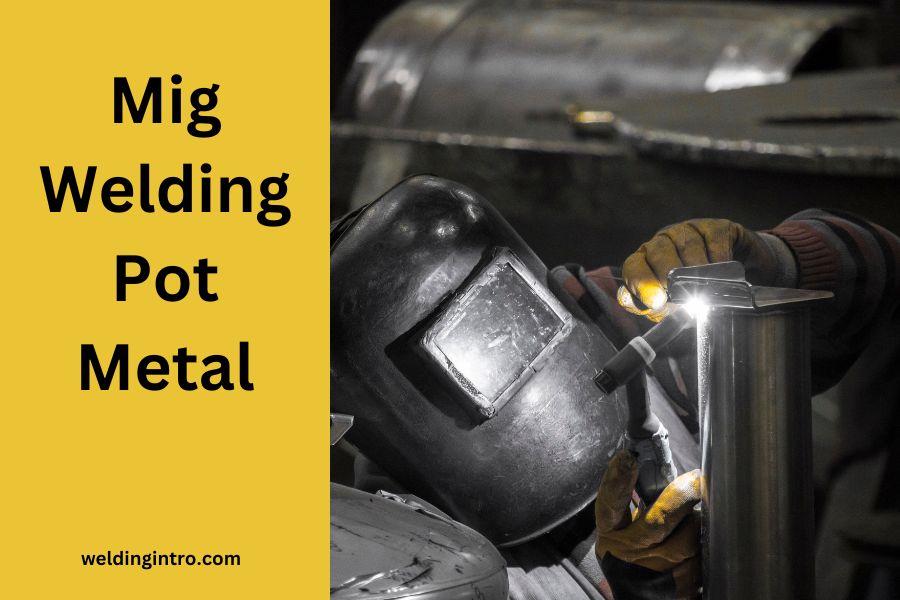You can MIG weld pot metals. But being extra cautious is mandatory because it is made from extremely soft metals. You also must have some prior practice and knowledge for better welding experience. Otherwise, it will create unwanted holes and ruin the pot metal.
Characteristics Of Pot Metal
Pot metal is also known as monkey metal. It is made from inexpensive materials without using any gold, silver, or platinum items.
Manufacturers mainly use an alloy of copper, zinc, magnesium, iron, cadmium, tin, and lead to create this silvery-white metal.
However, there is no hard and fast rule regarding what items to use to make pot metals.
Its melting point is 420 °C (786 °F), and its boiling point is 907 °C. Due to its lower melting point, it is pretty easy to cast.

Can I MIG Weld Pot Metal?
Welding pot metal is not going to be easy because the exact composition of its alloys is hard to determine.
You may end up creating holes in seconds on these soft and vulnerable metals if you just increase one degree of temperature.
You can weld pot metal using a MIG welding method. But utilizing specialized techniques and equipment is crucial to get the job done.
Besides, you need some prior practice and decent knowledge for better welding results.
What do You need To Consider While MIG Weld Pot Metal?
Whether you are a new or experienced welder, you can’t overlook the following factors.
01. Right Filler Metal
ER4043 is the most commonly used MIG filler wire. You can use it for MIG welding on pot metal.
The wire diameter should be small to minimize the heat output. It is strong and crack-resistant to avoid weld cracking problems. Alternatively, high-quality stainless steel or mild steel wire won’t be a problem.
02. Precise Amps Setting
Most welding metals require 125 amps to start the welding. But pot metals have a lower melting point. Hence, you need to keep amperage settings within 80 amps at maximum.
Avoid using higher amperage settings pot metal. Otherwise, it will cause bad arc starts, extremely wide weld beads, high spatter, and poor penetration.
03. Low-temperature Settings
Pot metal has a melting point of 420 °C (786 °F). So, keep the temperature as low as possible.
Too much heat will lead to downtime, wire burn back, wasted consumables, and lower productivity.
04. Sufficient Intervals
Maintaining 5-10 seconds of break between welding is a solid rule of thumb.
The welding area will be properly cooled down and solidifies in the time. You can achieve a better welding result by pause in mig welding a pot metal.
05. Determining Pot Metal
One of the trickiest tasks is determining the pot metal as they are made from various types of combined materials.
You can use the weighting technique to identify its type. For example, if the pot metal is heavier than regular ones, it is most probably made from die-cast metals.
Another handy technique is following the smoking color. If it releases white smoke, it is mainly made from zinc-based metals.
06. Enough Welding Time
How much time are you ready to spend for MIG welding on pot metals?
Make sure you have enough time to complete the welding session slowly and steadily.
Don’t rush! Otherwise, you will ruin your projects.
How To MIG Weld Pot Metal?
- Step-1: Instead of choosing a high-powered MIG welder, select an option that allows you to adjust the temperature, amperage, and other settings more precisely.
- Step-2: Make sure the MIG welder is capable of hooking up a gas tank up to it. Choose a 100% argon shielding gas for welding pot metal.
- Step-3: Wear all the right welding safety equipment to keep yourself safe during the welding.
- Step-4: Tune up the MIG welder perfectly to weld the pot metal. The wire speed, along with the voltage, should be neither too fast nor too slow
- Step-5: Maintaining a 15-degree travel angle for the welding gun is a good rule of thumb. It provides good penetration and a wide weld bead.
- Step-6: Pull the trigger and start welding the pot metal. Keep the arch hot enough to weld the metal effortlessly without burning through it.
- Step-7: You can travel around 1 inch of space every 8-10 seconds, depending on the metal thickness. But avoid waiting too long.
- Step-8: Once you complete the welding session, you will see a “bluing” appearance. Make sure your welding result doesn’t look really thin and snake-like.
Safety Tips For MIG Welding Pot Metal
- Make sure to use smaller diameter wire as pot metal is soft and thin.
- Use a correct current flow, voltage, wire feed, and gas flow setup.
- Avoid wearing synthetic materials prone to melt onto the skin when hot.
- Ensure proper ventilation and remove flammable materials from the working area.
Bottom Line
Are you still wondering about this question: Can you MIG weld pot metal?
You can get precise MIG welding results if you are cautious and properly tune up all the settings.
Practice on a rough pot metal before using it on the main item.
Related Articles